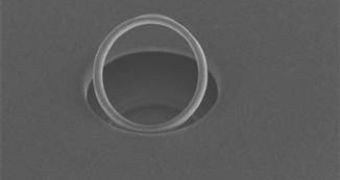Men around the world can now start celebrating the creation of the world's smallest diamond ring! Now everybody can afford a diamond ring. Too bad it is only 5 millionths of a meter in diameter and bears five-billionths of a carat of diamond, this meaning it can only be viewed through a microscope. The proud inventor of the diamond ring is the University of Melbourne. Previously, Japanese semiconductor manufacturer Hitachi High-Technologies held the record for the smallest diamond ring by creating one, through a process routinely used to create semiconductor computer chips.
Back in 2004, employee Yasushi Kuroda of the company's subsidiary Hitachi Science Systems, manufactured a device in order to demonstrate the capabilities of the company's equipment to make micro-machines. With the help of a gallium ion beam which helped inspect semiconductor chips, Kuroda managed to create a ring of tungsten - widely used as wire filaments for classic light bulbs - and diamond only 0.02 millimeter in diameter. Allegedly, the diamond material was collected from diamond polishing powder, claimed the company's officials.
Although it might have not realized it at the moment, Kuroda may have provided through this invention a basis on which developers can build new quantum information processing technologies. Diamond rings can be used as components in single photon detectors. Single photon detectors are extremely important in quantum computing.
Similarly to electrons, the particles of light, or photons, can carry information. The technology behind digital computers manufactured today allows them to process information in binary code only, meaning that at the basic level a single bit of information can only have one of two possible states. Either '0' or '1', corresponding to the operation of a switch which can only be either turned 'on' or 'off' at one time. A collection of '1' and '0' represents a piece of information encoded in binary language.
Photons can also carry such bits of information - qubits - thus depending on the properties of a particle of light, one such qubit can be associated with one of the two values, '0' or '1', and used as an information storage device.
According to Hitachi, the microscope picture of the ring was awarded the gold medal at the Asia-Pacific Conference on Electron Microscopy in 2004. The new diamond ring was presented this month at the American Physical Society in New Orleans, by University of Melbourne researchers.

 14 DAY TRIAL //
14 DAY TRIAL //